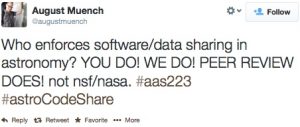One of the unconference sessions (proposed during the event) held at December’s .Astronomy was on software citation, this subject having come up in an earlier session on improving credit for software.
Discussion and comments in the session inspired me to look at astronomy’s current practices for citing software. Though not an exhaustive list, I looked in more than a dozen journals for citations for codes used in research, and below are some of the examples I gathered.
The most common way to cite software is to reference a paper describing the code. This is how, for example, the authors of yt would like that software cited, as shown from a recent MNRAS paper:
![]()
Sometimes a link to the website for a code is listed as a reference to it, as was done in a Classical and Quantum Gravity paper:
![]()
![]()
Conference proceedings are cited in some cases, as the citation below for WCSTools in an The Astrophysical Journal paper demonstrates:

ASCL entries can be cited, too, as shown in this citation for pynbody in a paper published in Physical Review D:
![]() Someone — I don’t remember who — reported that Google Scholar does not index mentions of codes, GitHub repos, etc. as citations, because they are not papers. An opinion tweeted out about this summed up the sentiment in the room pretty well! I plan to take this up with Google after the AAS meeting. Fortunately, ADS does index properly formatted software references; the only reference listed in this post that I didn’t see captured by ADS was the URL for CAMB, which is not surprising (nor expected).
Someone — I don’t remember who — reported that Google Scholar does not index mentions of codes, GitHub repos, etc. as citations, because they are not papers. An opinion tweeted out about this summed up the sentiment in the room pretty well! I plan to take this up with Google after the AAS meeting. Fortunately, ADS does index properly formatted software references; the only reference listed in this post that I didn’t see captured by ADS was the URL for CAMB, which is not surprising (nor expected).
A subsequent post will include additional information and a list of resources about software citation, to be posted before the first Special Interest Group on software publishing meeting scheduled at AAS225 that will be held on Tuesday, January 6, from 3:45 PM – 4:45 PM in 615 in the Convention Center. The main topic of this meeting will be software citation, and all interested parties are welcome to attend.
The journals below were part of my hunting grounds for software citations. Ever had a citation to software you used in research refused by a publication? If so, I’m interested in knowing the details; please share here or send them to editor@ascl.net. Thanks!
American Institute of Physics Proceedings
Astronomy & Astrophysics
Astronomy and Computing
The Astronomical Journal
The Astrophysical Journal
The Astrophysical Journal Supplement
Classical and Quantum Gravity
Icarus
Monthly Notices of the Royal Astronomical Society
Nature
Physical Review D
Proceedings of the SPIE
Publications of the Astronomical Society of Australia
Publications of the Astronomical Society of Japan
Publications of the Astronomical Society of the Pacific
Additional screenshots of software citations:
Formatting counts! Below, two citations for Turbospectrum, the first formatted in a way ADS can pick up and count the citation, the second one not.




